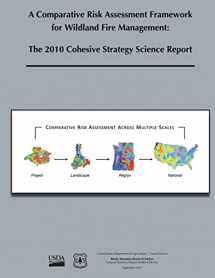
A Comparative Risk Assessment Framework for Wildland Fire Management: The 2010 Cohesive Strategy Science Report
ISBN-13:
9781480146549
ISBN-10:
1480146544
Author:
U.S. Department of Agriculture, Forest Service, David E. Calkin, Alan A. Ager, Matthew P. Thompson
Publication date:
2012
Publisher:
CreateSpace Independent Publishing Platform
Format:
Paperback
70 pages
Category:
Conservation
,
Nature & Ecology
FREE US shipping
Book details
ISBN-13:
9781480146549
ISBN-10:
1480146544
Author:
U.S. Department of Agriculture, Forest Service, David E. Calkin, Alan A. Ager, Matthew P. Thompson
Publication date:
2012
Publisher:
CreateSpace Independent Publishing Platform
Format:
Paperback
70 pages
Category:
Conservation
,
Nature & Ecology
Summary
A Comparative Risk Assessment Framework for Wildland Fire Management: The 2010 Cohesive Strategy Science Report (ISBN-13: 9781480146549 and ISBN-10: 1480146544), written by authors
U.S. Department of Agriculture, Forest Service, David E. Calkin, Alan A. Ager, Matthew P. Thompson, was published by CreateSpace Independent Publishing Platform in 2012.
With an overall rating of 4.0 stars, it's a notable title among other
Conservation
(Nature & Ecology) books. You can easily purchase or rent A Comparative Risk Assessment Framework for Wildland Fire Management: The 2010 Cohesive Strategy Science Report (Paperback) from BooksRun,
along with many other new and used
Conservation
books
and textbooks.
And, if you're looking to sell your copy, our current buyback offer is $0.05.
Description
Forests, rangelands, and other open spaces provide a broad array of ecological benefits, including critical habitat for protected species, drinking water, wood products, carbon storage, and scenic and recreational opportunities. Large, destructive wildfires threaten these values and communities adjacent to these lands. Large investments in wildland fire suppression and fuel reduction activities are being made throughout the United States in ongoing efforts to reduce human and ecological losses from wildfire (USDA and USDI 2001; Public Law 108-148 2003; Sexton 2006). Managing these investments is a challenge to multiple Federal, State, and local agencies as decision makers attempt to reduce wildfire risk over extensive areas while balancing public expectations with finite budgets (Agee 2002; Dicus and Scott 2006; Johnson and others 2006; Sexton 2006; Winter and Bigler-Cole 2006). Landscape-scale changes in vegetation structure and fuel loadings must be accomplished in order to significantly alter wildfire behavior, reduce wildfire losses, and achieve longer-term fire resiliency (for example, Agee and others 2000; Finney 2001; Peterson and others 2003; Graham and others 2004). However, the most efficient way to achieve these long-term landscape goals remains unclear, and there are different perceptions on the relative role and effectiveness of management activities versus natural and managed wildfire to reduce fuels (cf. Agee 2002; Finney and Cohen 2003; Reinhardt and others 2008). The FLAME Act of 2009 requires the U.S. Department of Agriculture Forest Service and the U.S. Department of Interior to submit to Congress a Cohesive Wildfire Management Strategy. In this report, we explore the general science available for a risk-based approach to fire and fuels management and suggest analyses that may be applied at multiple scales to inform decisionmaking and tradeoff analysis. We discuss scientific strengths and limitations of wildfire risk assessment frameworks, including the benefit of broad scalability as demonstrated by four recent case studies. We further highlight the role of comparative risk assessment, which extends the analysis to include the decision space available to managers and stakeholders to allow them to explore the tradeoffs between alternative courses of action. We identify scientific limitations of the analytical protocol and discuss questions of how to better address climate change, smoke modeling issues, and socioeconomic vulnerability, and how to better quantify treatment effectiveness. Key challenges are: achieving a balance between retaining analytical flexibility at regional and sub-regional planning scales while simultaneously retaining data and methodological consistency at the national scale, and identifying and aligning regional and national priorities to inform multi-objective strategy development. As implementation proceeds, the analytical protocol will no doubt be modified, but the contents of this report comprise a rigorous and transparent framework for comparative risk assessment built from the best available science.


We would LOVE it if you could help us and other readers by reviewing the book
Book review

Congratulations! We have received your book review.
{user}
{createdAt}
by {truncated_author}


